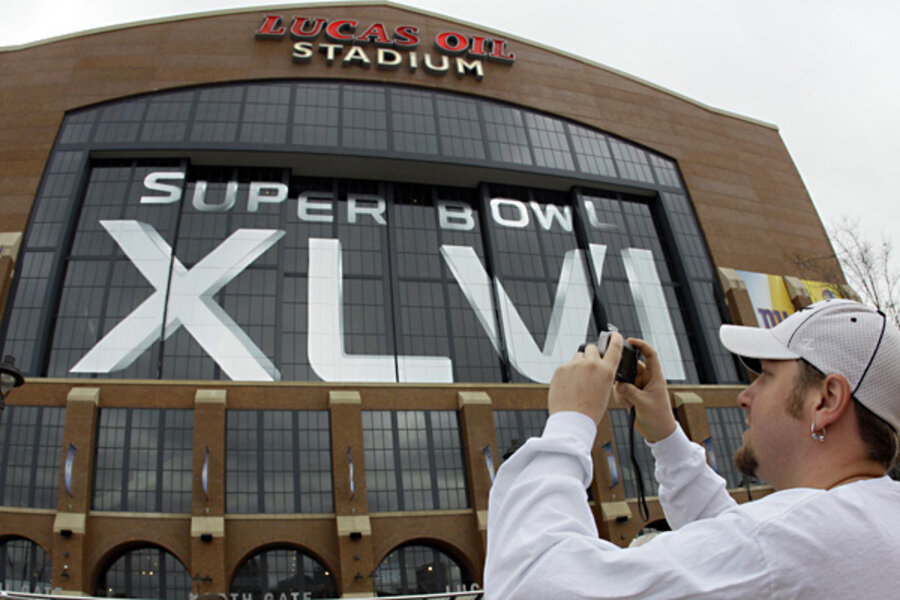Super Bowl cities: Is hosting a boon or a bust?
Loading...
This Sunday evening, virtually all eyes in the United States will be on the Giants and the Patriots in Super Bowl XLVI. They will also be on Indianapolis, the city charged with hosting this year’s big game.
For a small city, it seems like a golden opportunity: A Super Bowl means a huge spike in tourist dollars, a week of national exposure, and a featured spot in what is far and away the most-watched television event year after year. In 2008, the NFL estimated that host city Phoenix could expect to see a $500 million windfall during the four-day Super Bowl weekend. For Miami’s 2010 turn as host, the estimate was $400 million. But is playing host to the Super Bowl really as sweet a deal as it sounds?
Yes, it’s good, but maybe not that good. The windfall for Indianapolis will be closer to $150 million, according to Jack Ablin, an economist and the chief investment officer at BMO-Harris Private Bank, based in Chicago. “That’s based on 150,000 people spending a thousand dollars each,” he says. “And hopefully those numbers are a little conservative for Indianapolis.”
He points to Dallas, which enjoyed a $200 million boost from hosting the Super Bowl last year just as the city was recovering from a damaging ice storm.
[$150 million] is a pretty nice number,” says Victor Matheson, a professor of economics at College of the Holy Cross in Worcester, Mass. “Over the past decade we’ve had an escalation of these economic impact figures. Consultants dueling with one another to get a higher number, $400 or $500 million. That number is much more honest.”
According to Dr. Matheson, Indianapolis has a few things going for it that mean the Super Bowl will be a welcome boost. For one, it isn’t normally a winter destination, so the influx of tourism is actually a bonus. In warm weather destinations, like Miami, the tourism that comes from the Super Bowl would generally be replacing tourism that was already there.
"No one is in Indy in the middle of February,” he says. “In Miami and New Orleans, you’re displacing other tourists.”
Indianapolis’s small size (population: 829,718) also means a bigger relative boost. “Generally the amount of people that come to the Super Bowl is the same from city to city, so it will have a bigger economic impact [in a smaller city] than in a larger city,” Matheson states.
But small size can also work against cities. “Indianapolis will hit its capacity much faster than other cities,” Matheson points out. “In New York, you can have the Super Bowl and host other events at the same time.” He adds that much of the Super Bowl money made in smaller cities doesn’t tend to stay there. For instance, room rates for hotels will go up, but worker wages won’t. So the money generated goes to corporations based in other cities that own the hotels. “It doesn’t stick in Indianapolis.”
Furthermore, smaller cities often have to make major infrastructure investments to accommodate a Super Bowl. In 2005, Jacksonville, Fla. got creative in finding a temporary solution in meeting the NFL’s requirement for 17,500 available hotel rooms near the game site. The city docked cruise ships in the river that runs through the downtown area, providing the extra rooms needed as well as temporary bars and night clubs for the Super Bowl revelers. Clever, but it cost the city an extra $11 million.
Water-bound or not, cities make these investment in infrastructure to accommodate the Super Bowl with an eye towards lasting benefits. “What they’re hoping for is not just a near-term economic boost, but that the majority of Super Bowl attendees are corporate decisionmakers with the ability to bring long-term economic effects,” Ablin says. “Indy, for instance, has an elaborate shopping mall system that is connected from the stadium all the way to the convention center. Someone impressed with that may want to hold a conference or a convention down there.”
Despite its small size, Indianapolis is used to catering to large sporting events. In addition to the eight Colts home games per season, the city is home to the Indianapolis 500, and it hosted the NCAA Final Four in 2011.
But the Super Bowl bid was contingent on one major civic investment: the $780 million taxpayer-funded Lucas Oil Stadium, which became the Colts’ new home field in 2008. "The NFL awards the Super Bowl to places that build new stadiums. No way you put the Super Bowl in Indy in February unless the taxpayers build that new stadium,” Matheson insists.
So will the investment be worth it for Indianapolis? It might in the short term, but Ablin suggests it won’t have much of a long-term effect. “Probably tantamount to an economic sugar shock ,” he says. “No sober person would take the Super Bowl boost and draw a trend line.”
CORRECTION: An earlier version of this article listed Indianapolis as the smallest city ever to host a Super Bowl, when in fact several host cities, including Tampa, FL , Minneapolis, Min., and Arlington, Texas are smaller in population. The author has corrected this mistake.







